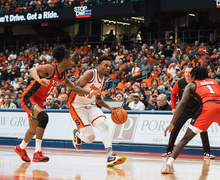Barillari: SA must become more united to create substantial, needed reform
Four candidates competed for the Student Association presidency in November. In their campaigns, they presented contrasting proposals for how to fix several problem areas within the organization. But the candidates did unanimously agree on one fact: SA needs reform.
President Allie Curtis believes she and her cabinet are bringing SA exactly that. The student body overwhelmingly elected Curtis, who, now one month into her yearlong term, said SA is in the best shape she has ever seen it.
“Every little aspect of SA is changing,” Curtis said, though not all members of the organization agree with this statement.
After the election, it was clear the next leader needed to improve internal inefficiency, improve SA’s relationship with registered student organizations and improve strategic student outreach. These are broad but critical issues within the organization, and a deficiency in any of these components curtails SA’s ability to execute its job effectively.
Internal changes so far include measures to curtail the time-consuming representative election process, introduced by Board of Elections and Membership Chair Emily Ballard. Curtis said she is working to rejuvenate the previously vague role of SA’s home college committees, as even members of the committees are unsure of how to operate them.
Outreach to registered student organizations was accurately presented as severely lacking during the campaign. Curtis said she and the president of the Graduate Student Organization are building a liaison system between the two organizations, and SA Vice President Duane Ford has created monthly summits during which presidents of student organizations can learn about SA procedures.
Connecting with the students themselves is another area in need of attention. Curtis’ biggest challenge thus far is motivating general assembly members to do more than attend the weekly meetings and make greater efforts to use their resources to “do more work that will actually affect the students,” she said.
It seems Curtis and her cabinet have employed a strategy of attempting to make many small changes to revamp the organization across the board. These concepts appear reformatory, potentially effective and should continue to be pursued.
But Comptroller Stephen DeSalvo does not share Curtis’ enthusiasm about the organization’s reform efforts. Though he is proud of the strides he and the Finance Board are making to be more effective financially for the student body, he does not feel there have been drastic changes made throughout the organization.
He said he has not witnessed much change internally or efforts to actually reform SA. But he does indicate that committee chairs and the chief of staff, specifically, are being very productive.
DeSalvo’s contributions to this session’s reform have been substantial. The restructuring of the tier system; the change to begin allocating funds toward transportation for large groups to travel off campus for events; and the improved fiscal training sessions for RSO members are all efforts to be applauded. These are tangible reforms that completely benefit Syracuse University students.
The lack of consensus about the progress being made throughout SA may be the root of the organization’s issues. How can a governing body successfully work together to reform if not all of the members are on the same page?
It is obvious that all want to improve the issues that surfaced during the campaign, but only the coming months of the 57th Session will tell whether Curtis can bring the assembly together to successfully achieve this.
Effective change does not have to come in the most drastic form or as a grand overhaul, but action from the entire assembly is in order. Curtis, cabinet and DeSalvo need to continue their respective projects and goals while creating a more united assembly in the process.
Rachael Barillari is the editorial editor and a junior political science and Middle Eastern studies major. Her column appears weekly. She can be reached at rebarill@syr.edu and followed on Twitter at @R_Barillari.
Published on February 11, 2013 at 1:15 am





